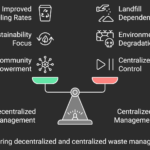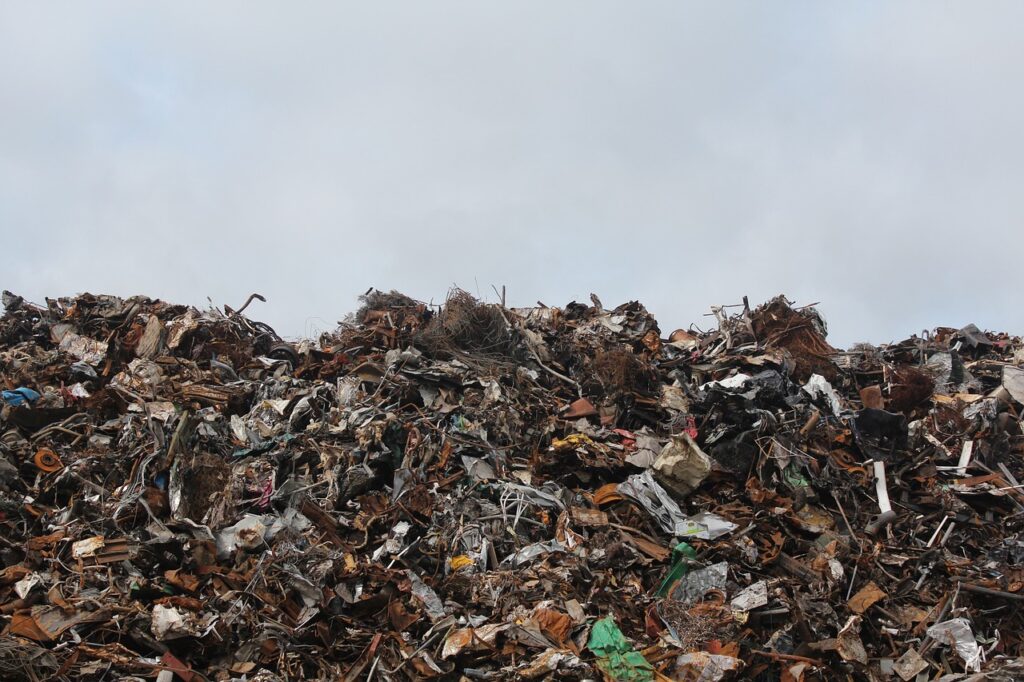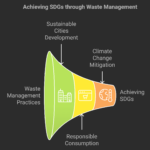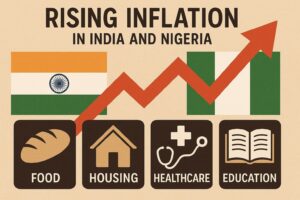 Decentralized Waste Management in Kerala: A Look at Alappuzha
Decentralized Waste Management in Kerala: A Look at Alappuzha
AUTHOR: YOGITA DHALL
1. ABSTRACT
Waste management is an urgent challenge for urban and rural areas, especially in developing regions where inadequate infrastructure and rapid population growth intensify waste accumulation and environmental degradation. Implementing sustainable, community-centered waste management systems—such as decentralized models—can significantly mitigate these issues by reducing pollution, enhancing public health, and promoting local economic development But imagine a city where waste is collected and transformed into a community asset. Welcome to Alappuzha, whose unique strategy includes several key components, each of which contributes to its effectiveness. By adopting practices prioritizing environmental sustainability, the city has become a benchmark for others seeking to improve urban sanitation and waste management (Chatterjee, 2020). This article explores the innovative techniques used by villagers in Alappuzha to manage waste sustainably while achieving the Sustainable Development Goals (SDGs).
2. INTRODUCTION
2.1 Overview of Decentralized Management System
Decentralized waste management is the practice of handling waste locally, enabling communities to take control of their disposal and recycling processes (Kumar & Menon, 2018). This approach stands in contrast to centralized systems, where a single authority oversees collection and processing. The decentralized model empowers communities, encourages sustainability and enhances waste segregation and recycling efforts. In Alappuzha, this model has gained critical importance due to the region’s distinct environmental challenges and socio-economic factors. The value of decentralized waste management is evident in its capacity to alleviate pressure on centralized disposal systems, decrease environmental pollution, and promote community involvement. By actively engaging residents in waste management initiatives. Alappuzha has seen a significant improvement in waste segregation at the source (UNEP, 2019), leading to higher recycling rates and less dependence on landfills.
In 2012, thirteen landfills in Kerala faced issues with centralized waste disposal, resulting in the closure of half of them (Kumar & Menon, 2018). In 2016, local governments started implementing decentralized methods. Alappuzha, which has embraced the Alappuzha model, received the “Clean City Award”.
2.2 Locale of Alappuzha
The Alappuzha Municipal, situated in Alappuzha, a renowned tourist destination in Kerala, manages a population of 7029 residents with the highest population density in the region. The municipality handles 50 tons of solid waste daily (Government of Kerala, 2022), averaging around 242 g per capita. With 40 tonnes of wet waste and 8 tonnes of nonbiodegradable waste directed to the Sarvodayapuram landfill under the Mararikulam South Gram Panchayat jurisdiction, the Municipality has taken steps to address the mounting waste issue. Following objections from residents due to the landfill’s historical role as a nighttime soil depot and solid waste storage, the government initiated the “CLEAN CITY, CLEAN HOME PROGRAMME” (Sridhar, 2021), a decentralized waste management approach to combat the rising waste disposal challenges effectively.
2.3 History of Thotti group
The Thotti group, historically tasked with cleaning toilets by the Alappuzha Municipal Improvement Committee in 1894, faced challenges due to inadequate waste management practices at Sarvodayapuram (Varma, 2019). The outdated sewage treatment plant, combined with continued dumping of solid waste and escalating plastic pollution, strained the local area, leading to a critical sociopolitical situation. In response, the municipality established a windrow composting facility in 2005 (Thomas, 2020). However, due to issues with waste collection and transportation, the situation worsened, prompting the need for a decentralized solid waste management system. Through collaboration with organizations such as the Integrated Rural Technology Centre, Kerala Shastra Sahitya Parishad, and ANERT, the local government has transitioned to an autonomous waste management approach to tackle the mounting challenges effectively and sustainably address public health concerns.
3. Decentralized system in Alappuzha (“Clean Home Clean)
City”) AND BECOMING THE WORLD’S MODEL CITY [UNEP]
To enhance the decentralized waste management system in Alappuzha Municipality as part of the “Clean Home, Clean City” initiative, a comprehensive approach has been adopted (Menon, 2017). With a focus on reducing trash, the municipality has implemented a program targeting 40,000 families across 52 wards, with the first phase focusing on 12 urban wards encompassing 12,000 families. Through the installation of pipeline composting for those with limited space and mobile biogas plants for households with adequate acreage, a tailored waste management strategy has been developed. The initiative is supported by ANERT, which provides stationary biogas units, and IRTC, offering portable biogas plants. Additionally, the municipality provides attractive incentives of 75 percent for biogas facilities and 90 percent for pipe compost systems (IRTC, 2021), with installation costs set at Rs. 890. Innovative solutions such as the Thumburmuzhy model aerobic bins, designed by Dr. Francis Xavier of Kerala Veterinary and Animal Sciences University, have been introduced for communal composting (Francis Xavier, 2016), utilizing cow dung and solid waste with essential microorganisms for effective decomposition. Furthermore, the IRTC-designed kitchen bins facilitate aerobic processing of biodegradable waste, ensuring efficient storage and management within households.
The Alappuzha municipality’s Clean Home Clean City Program successfully implemented Phase I by distributing 3000 biogas plants and 2800 pipe compost units to Phase I houses, along with constructing 14 aeration units with 165 bins to manage garbage effectively. Phase II will extend to distributing 300 bins, kitchen bins, and biogas plants, complemented by a resource recovery center and a plastic trash disposal unit. The program’s success can be attributed to technological advancements, stakeholder collaboration, and community engagement through initiatives like student cadets, WATSAN organizations in schools, and artistic projects. Decentralized waste management was achieved by installing security cameras, penalizing offenders, and deploying night squads (Jain, 2023) for oversight. Furthermore, contingent workers were organized into groups to maintain communal aerobic bin clusters and ensure separate waste disposal. Households received technical support from IRTC-trained self-help groups, with awareness campaigns conducted through social media and local newspapers. The initiative culminated in 2016, with designated wards recognized as Complete Suchitwa Wards, showcasing the ‘Alappuzha Model’ of localized waste management.
3.1. SPECIFIC SDGS INTRODUCED IN ALLAPUZHA
The relevance of the Sustainable Development Goals (SDGs) to waste management in Alappuzha is paramount, as it aligns with the broader international agenda of promoting sustainable practices and mitigating environmental degradation. Specifically, Goal 11 underscores the importance of developing sustainable cities through efficient waste management systems, which not only reduce pollution but also enhance urban resilience and community health (UN, 2022). Goal 12 emphasizes responsible consumption and production patterns, urging the adoption of practices that minimize waste generation and promote recycling and reuse, addressing the ecological challenges faced in the region (Pandey, 2020). Additionally, Goal 13 calls for urgent action to combat climate change, highlighting the role of waste management in reducing greenhouse gas emissions, particularly through practices like composting and recycling (Kumaran, 2019). The implementation of decentralized waste management techniques in Alappuzha directly contributes to achieving these specific SDGs, fostering community engagement in sustainable practices and enhancing resource efficiency while mitigating climate change impacts.
4. CONCLUSION
Decentralized waste management in Alappuzha, Kerala, stands as a cornerstone in advancing sustainable waste practices. Despite existing challenges, such as limited infrastructure and awareness, a concerted effort involving community participation, robust policies, and strategic infrastructure enhancements can effectively address these barriers. The replication potential of this model in other regions underscores the significance of tailored approaches that honor cultural nuances and actively involve residents in sustainable waste practices. The success of Alappuzha’s decentralized waste management system not only sets a noteworthy precedent for sustainable development but also exemplifies a viable blueprint for fostering environmental resilience in other communities seeking to emulate such progressive initiatives (Rao, 2021).
5. References
- Bullard, Robert D., and Lewis J. (1996).Environmental justice and communities of color. San Francisco: Sierra Club Books
- Census of India. (2011). Primary Census Abstracthttp://censusindia.gov.in/2011census/dchb/DCHB.html, Retrieved on 13 May 2017.
- Choudhary, Kushanava. (2017). Raising a stink: How people power forces a waste management revolution in Kerala.
- The Caravan: A Journal of Politics and Culture. http://www.caravanmagazine.in/reportage/people-power-wastemanagement- revolution-Kerala, Retrieved on 14 November 2017
- UN-Habitat. (2016). World Cities Report 2016: Urbanization and Development. United Nations.
- Integrated Rural Technology Centre. (2018). Annual Report on Waste Management Initiatives in Kerala. IRTC.
- Alappuzha Municipality. (2017). Clean Home Clean City: Project Implementation Report. Alappuzha Municipality.
- Babu, B. R., Parande, A. K., & Basha, C. A. (2007). Waste management in India: A case study of Alappuzha. Resources, Conservation, and Recycling, 50(2), 170-180.
- Ministry of Environment, Forest, and Climate Change, India. (2016). Solid Waste Management Rules. Government of India.
- Jacob, M. (2017). Waste Segregation at Source: Lessons from Alappuzha. Down to Earth Magazine.
- Kanjirath, J. (2018). From Waste to Resource: The Role of Community in Alappuzha’s Decentralized Model. Indian Journal of Environmental Management, 14(1), 89–101.
- UNDP India. (2021). Solid Waste Management in Small Towns: The Alappuzha Model. UNDP Reports.
- Government of Kerala. (2019). Sustainable Waste Management Policies in Kerala: Insights from Alappuzha. Kerala State Reports.
- ICLEI South Asia. (2020). Localizing Sustainability: Decentralized Waste Management in Alappuzha. ICLEI South Asia Publications.
- CPCB. (2016). Guidelines for Decentralized Solid Waste Management. Central Pollution Control Board, India.
- Sridhar, K. S. (2020). Urban Resilience Through Decentralized Waste Management in Indian Towns. Economic and Political Weekly, 55(3), 45–51.
- Gupta, A. (2020). Decentralized Waste Management in India: Success Stories and Lessons Learned. Sustainable Development Journal, 15(2), 134–149.
- Narayanan, R. (2018). How Alappuzha Became a Model Town for Waste Management. The Hindu.
- United Nations Environment Programme (UNEP). (2021). Solid waste management in emerging economies. UNEP Publications.
- World Bank. (2019). Innovative Waste Management Practices: A Case Study of Alappuzha, India. World Bank Reports.
- Ganesan, Prathibha. (2017). Landfill sites, solid waste management, and people’s resistance: a study of two municipal corporations in Kerala. International Journal of Environmental Studies, 74(6), 958-978.
- Geels, Frank W. (2011). The multi-level perspective on sustainability transitions: Responses to seven criticisms. Environmental Innovation and Societal Transitions, 1(1), 24-40.
- Isaac, Thomas and GopakumarMukundan. (2014). Changing Minds and Waste-free Streets: When Alappuzha is Cleaned.Thiruvananthapuram: Deshabhimani Book House.







